Perforated Metals
Perforated metals, as the name suggests, are metal sheets that have been pierced through various processes (such as punching) to create different patterns and shaped holes. These holes can be either decorative, functional, or a combination of both.
The types of hole patterns available include staggered round, staggered center, straight square slot, round and line square, round slot end, side staggered, square staggered diamond, chain link, cross, hexagon, center, square hole patterns, and decorative cutouts like stars and flowers.
Perforated Metals FAQ
What are perforated metals used for?
Perforated metals are used in filtration, screening, acoustics, insulation, construction, waste management, furniture design, and security barriers. They also serve industries such as architecture, automotive, food processing, and chemical production.
Which metals are commonly perforated?
Commonly perforated metals include stainless steel, aluminum, copper, and brass. Specialty steel grades, galvanized metals, and alloys are also used depending on strength, corrosion resistance, and decorative needs.
What advantages do perforated metals provide?
Perforated metals provide strength, durability, and aesthetic flexibility. They reduce energy costs, support acoustic control, and withstand mishandling. Their versatility makes them ideal for architectural facades, sound absorbers, and filtration systems.
How are perforated metals manufactured?
Perforated metals are made using techniques such as standard punching, XY-axis CNC punching, rotary pinned rollers, die-and-punch presses, and laser perforation. Finishing processes like polishing and grinding prepare sheets for final applications.
What are popular perforation patterns?
Popular patterns include staggered round, diamond, hexagon, square, chain link, cross, slots, and decorative shapes like stars or flowers. The choice depends on functional needs such as sound transparency or decorative appeal in construction and design.
What industries rely on perforated metals?
Industries such as construction, architecture, automotive, aerospace, food and beverage, chemical, energy, and acoustics rely on perforated metals for products like screens, filters, vents, panels, acoustic barriers, and structural components.
What is the difference between perforated and expanded metal?
Perforated metal is created by punching holes or patterns into sheets, while expanded metal is slit and stretched to form diamond-shaped openings. Expanded metal is cost-effective, but perforated metal allows finer holes and greater design flexibility.
The History of Perforated Metals
Perforated metals have been used for decorative purposes for centuries, but they didn't see industrial application until the 19th century. During this time, manufacturers manually perforated screens to sift and separate mined coal. For many years, the perforated metal screen was the primary product used in industry.
As new manufacturing techniques, fabrication methods, and technologies emerged, perforated metal manufacturers adapted their practices. Specifically, they began creating custom presses with dies designed specifically for perforated metals.
The manufacturing landscape shifted again with the advent of presses and technologies such as rotary pinned perforation rollers and laser perforation. These advancements significantly improved fabrication efficiency and consistency, allowing perforated metals to compete with other materials. This led to their widespread use in construction, including in access control sheets, acoustic control measures, and heat-saving facades.
Today, metal perforation continues to have a growing impact on various industries, helping in applications from aerospace to environmental impact filtration.
There are many advantages to choosing perforated metals over other alternatives. First, they offer superior structural integrity and strength. Additionally, the functionality of perforated metals has grown significantly over the years, expanding their versatility. Their aesthetic appeal has also grown, with perforated metal sheets now being integrated into building facades. This not only adds architectural creativity but can also contribute to energy savings of up to 25%.
In acoustic applications, perforated metal sheets stand out because they can be refurbished and cleaned without compromising the absorptive properties of acoustic equipment. They are also resistant to mishandling and other forms of damage, making them highly durable.
Lastly, perforated metals can be fabricated into complex shapes for visual purposes, thanks to modern fabrication methods. These techniques enhance efficiency, ensure consistent results, and eliminate human error in the metal perforation process.
Materials Process
The most commonly perforated metals include copper, stainless steel sheet, and aluminum. Alloy manufacturers also produce a wide variety of alloys, including brass and specialty steel grades. Galvanized and regular perforated metals are used depending on the application. Each type of perforated material has its own unique properties and uses, which are detailed below.
Perforated Copper
Perforated copper is recognized for its reddish tint, making it ideal for decorative purposes. It performs well in a range of temperatures and is resistant to rust when exposed to water. As an excellent conductor of heat and electricity, copper is widely used in applications such as interior and exterior design, tubing, and shielding.
Stainless Steel
Perforated stainless steel is strong, lightweight, corrosion-resistant, rust-resistant, and antibacterial. It comes in 15 different grades, with carbon steel also being commonly used. These properties make perforated steel and stainless steel versatile materials in industries like healthcare and pharmaceuticals.
Aluminum Perforated Sheet
Aluminum perforated sheets are valued for their corrosion and rust resistance, heat resistance, strength, and durability. They are widely used in applications such as office refurbishments, railings, stairways, and in technologies like Micro-Electro-Mechanical Systems (MEMS) capacitive microphones.
Perforated Brass
Brass, like copper, has a gold-like shine, making it a popular choice for decorative applications. It is relatively resistant to tarnishing, an excellent thermal conductor, and a good electrical conductor. Perforated brass is commonly used in HVAC applications, electronics, and heating systems.
Process Details
Select the Appropriate Material
The first step is choosing the right material for the project. The choice of metal depends on the intended application and properties required, such as strength, corrosion resistance, and aesthetics.
Determine the Appropriate Sheet Gauge
Sheets come in varying thicknesses and are measured by gauges—note that the larger the gauge number, the thinner the sheet. Selecting the correct sheet gauge is as crucial as choosing the material itself. Perforated metal sheets used in fabrication are typically thin and flat, so it's essential to choose a gauge that matches the requirements of the project.
Choose Your Perforation Pattern
There are numerous pattern options, ranging from staggered squares to intricate floral designs. The choice of perforation pattern depends on both functional and aesthetic needs.
Bend, Weld, Punch, and Cut
Perforating sheet metal can be done in different ways, depending on the complexity and design of the hole patterns. The two main methods are standard punching and XY-axis punching.
Standard Punching
For simple perforations, a standard punching press is used. In this method, the sheet metal is fed slowly into the press, which contains the designed hole pattern, and the metal is perforated as it passes through.
XY Axis Punching
For more complex and decorative designs, an XY-axis punching press is used. This CNC-controlled press offers high precision and is perfect for creating intricate, non-repetitive patterns.The sheet metal is secured to the machine, and the punching rams move along the X and Y axes, creating a detailed design as the sheet moves through the press.
Finishing
Once perforated, the metal undergoes finishing processes, such as surface polishing and rounding. Depending on the application, manufacturers may polish the sheet either mechanically or with electric methods. The metal is then degreased, blasted with beads or sand, and may undergo additional grinding or brushing techniques to smooth the surface and prepare it for use.
When designing perforated metals, manufacturers consider a variety of factors to ensure that the final product meets both functional and production goals.
Manufacturing Speed
One important factor is manufacturing speed. If time is a critical consideration, manufacturers may choose to use roll-formed coils rather than perforating individual sheets. This method tends to be faster as it allows for continuous production, reducing the time spent on setup between perforation cycles.
Perforation Patterns and Application
Another key consideration is the perforation pattern, which is tailored to the specific application. For example, in audio applications, manufacturers focus on sound transparency to determine the ideal perforation pattern. The transparency index indicates how effectively sound waves can pass through the material. For high sound transparency, manufacturers typically use closely spaced perforations, as these allow more sound to pass through. Conversely, for low sound transparency, they use larger perforations with a smaller open area, reducing the amount of sound that can pass through.
Industry Requirements and Space Constraints
Manufacturers also need to factor in industry-specific regulations, space limitations, and the overall needs of the application. The design of the perforated metal must align with the product's intended use, whether for structural, aesthetic, filtration, or acoustic purposes.
By considering these various elements, manufacturers are able to create perforated metal products that meet both performance and production efficiency standards.
Machinery Used in the Process
Wide Press
The wide press perforation method is the most widely used and cost-effective option. This process involves punching the entire width of a metal plate in each strike of the die. As the plate moves through the machine, multiple punch rows or an array of punch rows work simultaneously to create the perforations. While wide press perforation is fast, it can sometimes result in stress faults or distortions due to the force of punching. Additionally, the tooling costs for this method can be quite high, which makes it ideal for high-volume production.
To correct these stress faults or distortions, a leveler is used to flatten the processed plates. The leveler removes these imperfections by evenly distributing the pressure across the plate. However, leveling is not a standard process and varies depending on where the non-perforated and perforated areas are located.
Sectional Press
Sectional press perforation involves working on a specific area or section of a plate rather than perforating the entire width. This technique is more suitable for jobs requiring tailored perforation patterns, and it is commonly used when lower production rates are acceptable. The production rate is slower than the wide press method, but sectional press tooling is less expensive. With modern Computer Numeric Control (CNC) technology, it is easy to pre-program perforation areas and patterns, which adds flexibility to this technique. Sectional presses are often used for thicker plates (up to 20 mm), as they require fewer punches.
Automatic Nibbling Machines
Automatic nibbling machines work similarly to sectional presses but with the added benefit of automation. The machine automatically changes the tools needed for perforations, which reduces manual labor. It also nibbles the contours of the metal sheet to create custom shapes. This method is highly efficient for creating a variety of perforations economically, and it can also finish the outer contours of the plate if needed.
Manufacturers utilize various machinery options to create perforated metal products that meet specific requirements, such as hole size (measured in mm), hole diameter, open area, and the strength-to-weight ratio. The choice of machine depends on the complexity of the design, the volume of production, and the specific characteristics required for the final product.
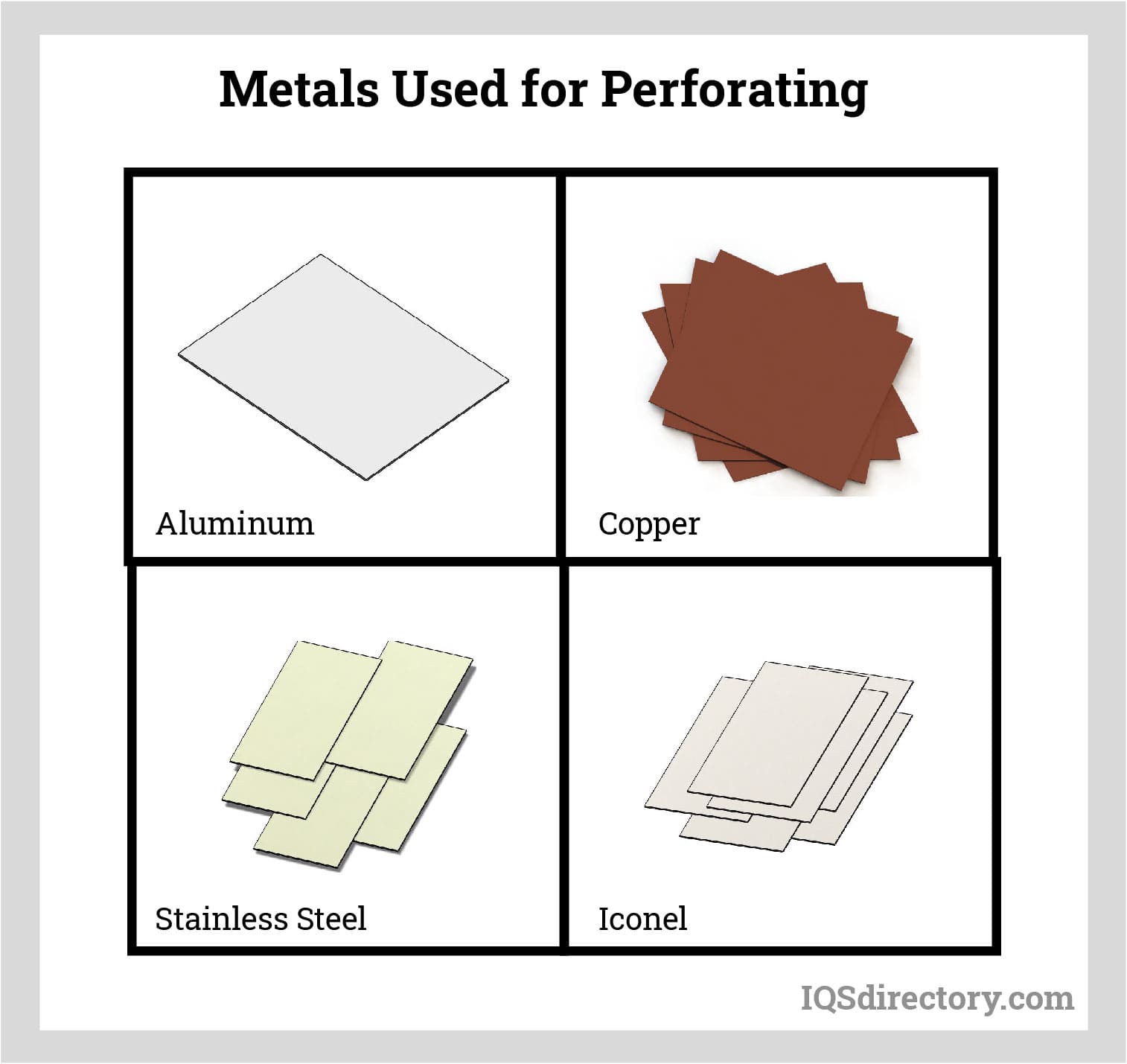 The different metals that can be used for a perforating pattern, however the thickness of the mteal affects the amount of time to finsih the final product.
The different metals that can be used for a perforating pattern, however the thickness of the mteal affects the amount of time to finsih the final product.
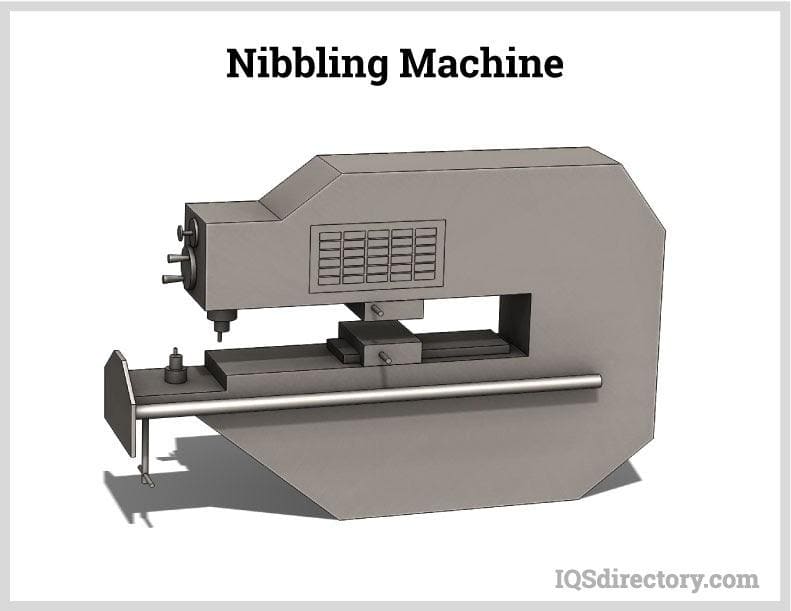 Nibbling, a production process where the metal sheet is cut in stages using a punch using an electrohydraulic motor.
Nibbling, a production process where the metal sheet is cut in stages using a punch using an electrohydraulic motor.
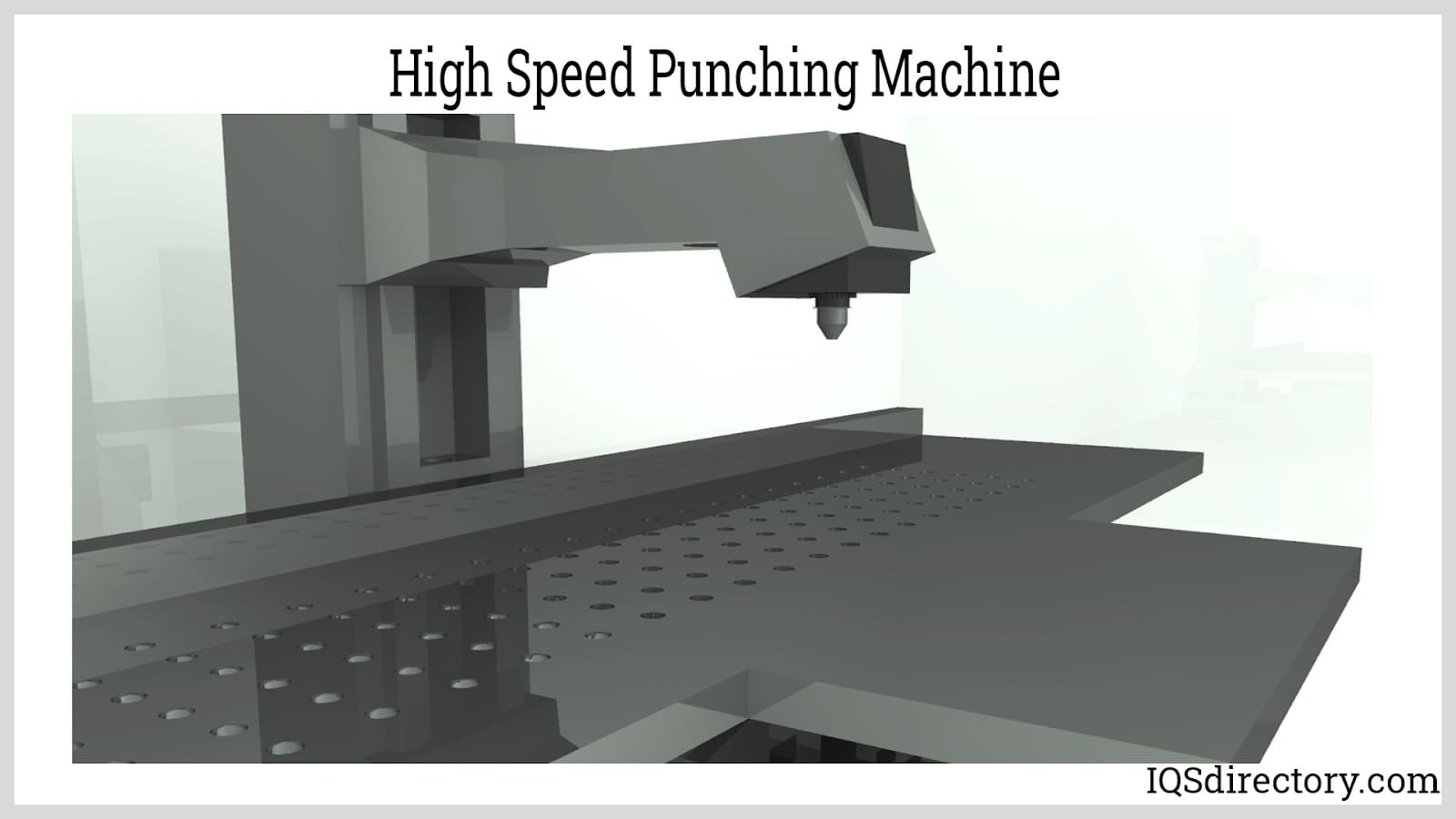 A punching machine functions much like a wide punch press that moves across the sheet metal placing symmetrical holes section by section.
A punching machine functions much like a wide punch press that moves across the sheet metal placing symmetrical holes section by section.
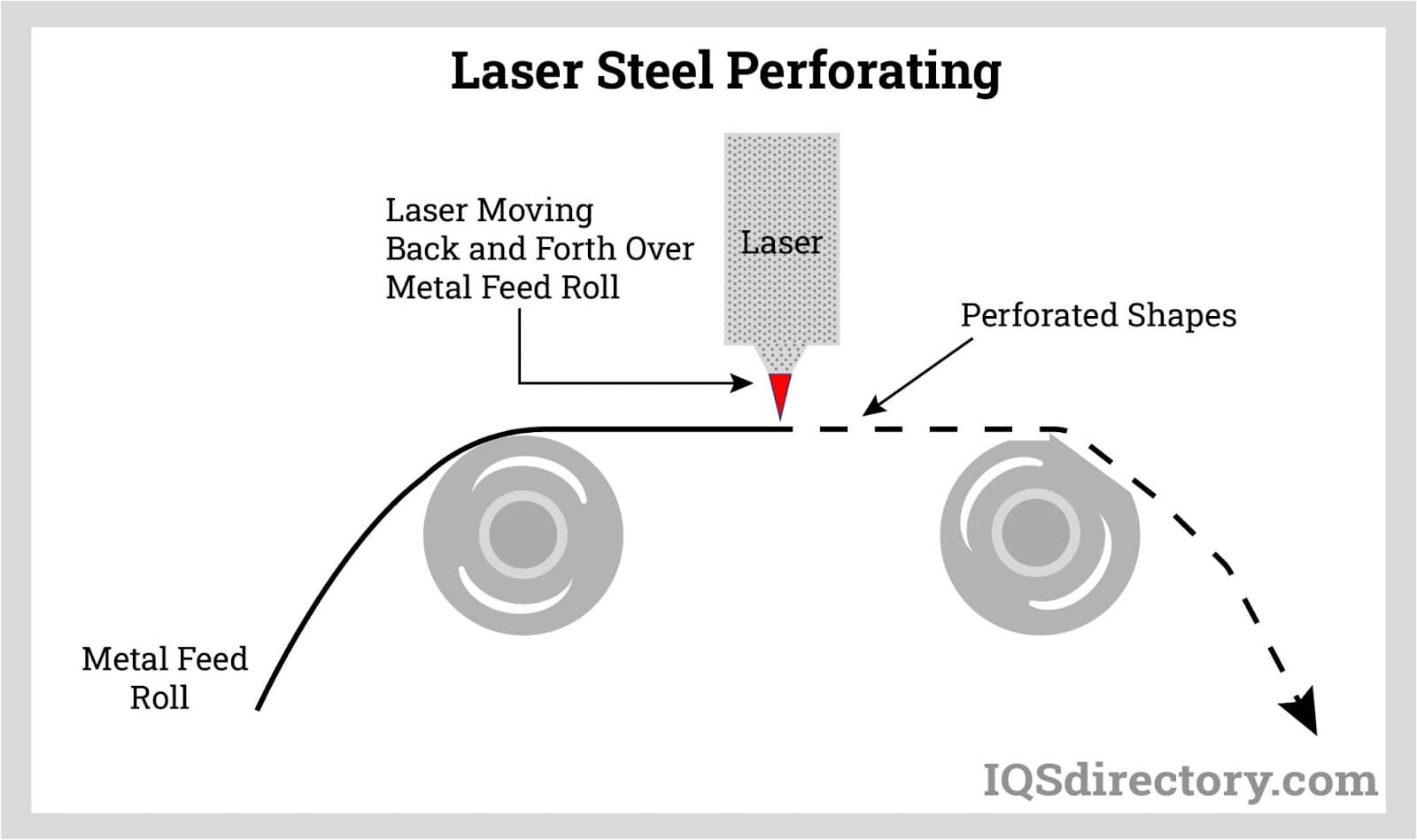 A laser perforating machine acts like an electronic pen for cutting complex and intricate patterns into steel metal sheets.
A laser perforating machine acts like an electronic pen for cutting complex and intricate patterns into steel metal sheets.
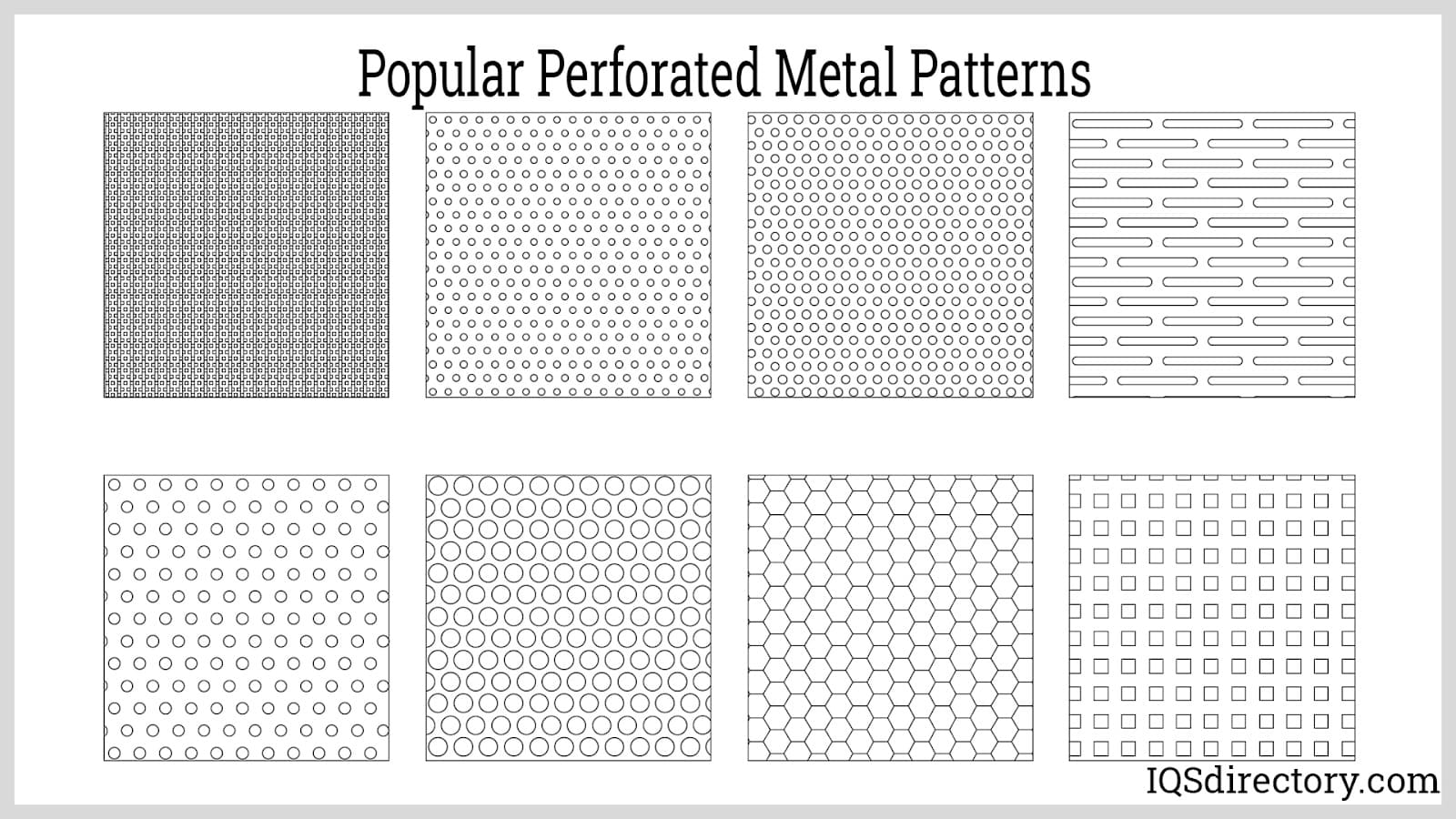 A perforated metal is a piece of sheet metal that has been stamped, fabricated, or punched to create a pattern of holes, slots, and various aesthetic shapes.
A perforated metal is a piece of sheet metal that has been stamped, fabricated, or punched to create a pattern of holes, slots, and various aesthetic shapes.
- Architectural Perforated Metal
- These are punched metal sheets used in building construction for various applications, from decoration to functional structural support.
- Bar Grating
- A heavy-duty expanded metal featuring thicker bearing bars, used primarily for industrial flooring, stairs, and transportation systems like street or railroad grating.
- Filter Screens
- Screens designed to regulate the flow of fluids, light, or noise, commonly used in light fixtures, window openings, and acoustic applications.
- Floor Grating
- Durable, expanded metal arranged in a grid pattern, typically used in flooring, stairs, and catwalks for light to moderate traffic areas.
- Metal Panels
- These are metal sheets used in construction for insulation, decoration, and providing structural support in buildings and architectural applications.
- Perforated Aluminum
- Aluminum sheet metal that has been perforated by a punch to create holes or other patterns.
- Perforated Brass Sheets
- Brass sheets that have been punched with holes or other shapes for various uses in construction or design.
- Perforated Copper Products
- Copper sheets or panels with holes or patterns created by punching, used in architectural and industrial applications.
- Perforated Metal Panels
- decoration, and a variety of functional applications.
- Metal Screens
- Used to block substances or objects from entering enclosed areas, providing security, protection, or filtration.
- Perforated Plates
- Metal plates punched with decorative or functional shapes, often used in construction or design.
- Perforated Sheet Metal
- Metal sheets that are perforated for use in screens, tubing, panels, and grating across multiple industrial and construction sectors.
- Perforated Sheets
- Sheets of metal that have been punched with specific shapes for various applications.
- Perforated Stainless Steel
- Stainless steel sheets, plates, or panels that have been perforated with holes or other shapes, often used for strength and durability in demanding environments.
- Perforated Steel
- Steel sheet metal that has been perforated to create various patterns, used in construction, design, and industrial processes.
- Perforated Tubes
- Metal tubes perforated with holes, used for filtration, light and fluid diffusion, shielding, or sound dampening applications
- Radically Cut Grating
- Panels with annular shapes cut out of rectangular grating, designed for use in circular or annular areas.
- Reversible
- Grating that can be installed with either side facing up, with no change in appearance or performance capacity.
- Riveted Grating
- Made of straight bars and bent connecting bars joined by rivets at the points of contact, commonly used for secure and durable grating.
- Standard Expanded
- Metal that begins as a solid sheet, which is then uniformly slit and stretched to create diamond-shaped openings, commonly used for grating.
- Swage-Locked Grating
- A type of grating made by applying pressure through dies to alter the shape of a metal cross bar, enhancing its durability and strength.
- Wire Cloth
- A versatile material available in various weave patterns, used in applications such as air filters, ventilation covers, animal cages, window guards, and clothes dryers.
Applications
Perforated metals have a wide range of uses. Their most common applications include filtration, screening, structural components, acoustics, insulation, building construction, waste management, furniture design, and security barriers.
Key industries that utilize perforated metals include architecture, food and beverage, chemical and energy sectors, material development, automotive engineering, and acoustics.
Products Produced
Perforated sheet metal is often used to create a variety of products, including screens, filters, strainers, piping inserts, trash cans, tubing, light fixtures, vents, audio speaker covers, patio furniture, and more.
Architectural Products
In architecture, perforated metal is used for products such as perforated metal panels, sunshades, cladding, eco-friendly aesthetic elements, decorations, signage, fencing, access control systems, and column covers.
Food and Beverage Products
In the food and beverage industry, perforated metals are found in products like grain dryers, fish screens, silo ventilation screens, perforated metal strainers, juice press screens, wine vat screens, cheese mold screens, and man-made beehives. Modern beehives, made from perforated metals, resolve past issues where bees would destroy entire hives with their own constructions, requiring the bees to start over.
Chemical and Energy Products
Perforated metals are heavily used in the creation of filters. For example, centrifuges in labs, drying baskets in washing machines, separator plates in batteries, screens in gas, water, and air purifiers, and traditional coal washing and mining cages all utilize perforated metal as a key component.
Material Development Products
Perforated metal is used in material development to strengthen glasses that withstand extreme manufacturing environments. It's also used in manufacturing screens for cement slurry, textile printers, felt mills, dyeing machines, and blast furnace screens, which are designed for high-temperature environments.
Automobile Products
Perforated metal is used in material development to strengthen glasses that withstand extreme manufacturing environments. It's also used in manufacturing screens for cement slurry, textile printers, felt mills, dyeing machines, and blast furnace screens, which are designed for high-temperature environments.
Acoustic Products
In acoustics, perforated metals play a crucial role in diffusers, protective coverings, and sound absorbers.
- Protective Covering
- Architects today are increasingly using perforated sheet metal as a decorative covering for acoustical materials. These coverings can reflect, scatter, and absorb sound waves. The perforations allow sound waves to pass through and reach the acoustic equipment placed behind them, providing an effective solution for various sound frequencies.
- Sound Absorbers
- Perforated metals can be used as resonant sound absorbers, which absorb sound waves of specific frequencies. This is particularly useful for filtering out certain frequencies and reducing sound noise. The design of the perforated sheets enables them to trap a layer of air, enhancing their performance in sound cancellation. Unlike other materials, perforated metal makes resonant sound absorbers more efficient, especially when tuned to 120 Hz, eliminating the need for large spaces or thick layers of absorptive materials in acoustical environments.
- Diffusers
- In aerodynamic facilities, such as wind tunnels, perforated metal sheets are used as diffusers to break up airflow turbulence, providing necessary acoustical properties.
Perforation Variations
Rotary Pinned Perforation Rolling
Rotary pinned perforation rolling is often regarded as one of the most efficient methods for producing perforated metal sheets. In this process, a large cylinder with sharp, pointed needles—known as a rotary pinned perforation roller—is used to punch holes of various diameters into moving metal sheets. The needles on the roller may be heated, causing the metal to melt around the punched hole and form a reinforcing ring. This continuous punching process makes rotary pinned perforation both cost-effective and efficient. Different needle types are used for creating holes of varying sizes.
Die and Punch Perforation
Die and punch perforation is another common method used to create perforated metal sheets. In this process, a die punches holes into the metal sheet with the help of a mechanical or hydraulic press. While this method involves a single operation, it requires secondary processes to remove any leftover metal and smooth the surface. Die and punch perforation is particularly suited for punching large areas of metal sheets.
Laser Perforation
Laser perforation is a modern technique that uses laser technology to create perforations. Although it is more expensive, laser perforation offers high precision and is typically used when exact measurements are critical. This process ensures a consistent and accurate result, especially for complex or intricate perforation patterns.
Among the various perforation methods, press and punch perforation is widely considered one of the most effective and efficient. Modern perforation presses, integrated with computer programming, provide extreme precision and allow for the production of virtually any perforation pattern.
Metal Expansion
Expanded metals are similar to perforated metals but are created through a different process. Instead of punching holes into a sheet, expanded metal is cut and stretched into a framework. This process is cost-effective and environmentally sustainable, as it produces minimal waste and can increase the surface area of a metal sheet by up to 70%.
Expanded metal is often used for similar applications as perforated metal, including enclosures, grating, shelving, and protective guards. While it is a cost-effective alternative in some cases, perforated metal offers finer holes and greater versatility in terms of hole configurations. This makes perforated metal ideal for applications such as metal screens, filters, and construction designs. The choice between expanded and perforated metal ultimately depends on the specific application, budget, and design requirements. Perforated metal remains a preferred option due to its ease of manufacture, cost-effectiveness, and adaptability across various industries.
There are many excellent perforated metal manufacturers available, but how do you choose the right one for your needs? The key is to focus on service. The ideal manufacturer will prioritize your needs, offering a personalized approach that makes you feel comfortable and confident. They’ll listen to your specifications, understand your requirements, work within your budget, and meet your timeline. They’ll also ensure your perforated metal product meets all necessary standards. Start your search by browsing the websites of the skilled and reputable companies we've listed above to find the perfect fit for your project.
- Anchor
- A device used to secure perforated metal grating to its support structure.
- Band
- Flat metal bars that connect each end of the bearing bars in a perforated metal grating.
- Bearing Bars
- Individual strips of metal that form the framework of perforated metal grating panels, providing support for the applied load.
- Bond
- The point where two strands of expanded metal intersect.
- Carriers (Punched Plate)
- Angles or flat bars welded to the perforated metal grating to provide additional support.
- Cold Rolling
- The process of passing unheated metal through a pair of roller dies to increase strength and reduce thickness. This process is used to flatten expanded metal.
- Cross Bars
- Bars that run perpendicular to the bearing bars in expanded metal grating.
- Deflection
- The degree of deformation that occurs when stress is applied to perforated metal grating. An acceptable level of deformation typically measures around 0.25.
- Finish
- A protective coating applied to perforated metal grating, typically in the form of paint or galvanizing.
- Open Area
- The gaps or spaces within expanded and perforated metals that are bordered by the metal strands.ds.
- Pressed-Locked
- A manufacturing technique for perforated metal grating in which a specialized press deforms the cross-bars, locking the bearing bars into position, providing an alternative to riveting and welding.
- Random Sheared
- A shearing method that results in jagged or pronged edges on the expanded metal.
- Serration
- The addition of notches along the edges of expanded metal grating to enhance slip resistance.
- Shearing
-
The process of trimming metal to the specified size and shape required by the design.
- Slitting
- The process of reducing the width of a metal strip to meet specific design criteria.
- Strand
- The individual metal strip that forms the pattern framework of expanded metal.
- Tread
- A grating panel to which carrier end plates and nosing are welded, specifically designed for use as stairs.
-